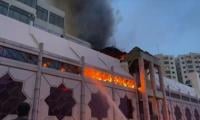In the early hours of a sweltering summer day on June 13, Iran was struck by Israeli aerial missile attacks. The air-launched missiles homed in with eerie precision, targeting top Iranian military leaders and nuclear scientists.
The fact that the exact locations of these high-value individuals were known so accurately strongly suggests the involvement of an insider – someone who likely marked the targets for Israeli-guided ‘fire-and-forget’ weapons such as the Hellfire missile, as well as other precision-guided munitions like the AGM-88 HARM and AGM-142 Popeye.
Grainy footage showing Israeli commandos preparing precision-strike weapons within Iran to disable Iranian air defence systems was a clear indication that Israel employed an infiltration-based strategy similar to the one used in support of Ukraine against Russia.
Israel had apparently planned the strikes meticulously, cultivating a network of collaborators inside Iran who aided in identifying targets and neutralising air defences ahead of the surprise attack. Favourable geography in post–Bashar al-Assad Syria and cooperation from Iraqi airspace also enabled Israel to deliver a decapitating first strike that shocked the IRGC and the broader Iranian military establishment.
Although there were no confirmed reports of missile penetration into underground nuclear facilities at Natanz and Fordow, above-ground infrastructure was effectively targeted. The attacks resulted in the deaths of more than 80 Iranians and prompted a wave of defiant rhetoric from the Iranian leadership.
If Israel had hoped to halt Iran’s nuclear development or coerce the country into renouncing its uranium enrichment programme, the opposite occurred. The Iranian leadership stood defiant, vowing retribution against Israel and any country supporting it. These words were translated into action on June 14, when 200 Iranian ballistic missiles hurtled into the formidable gaze of Israel’s much-vaunted three-tiered air defence system.
A few of these missiles managed to evade Iron Dome (4–40 km range), David’s Sling (40–300 km), and Arrow-3 (up to 2,400 km), causing limited casualties and some damage to residential areas. In response, Israel escalated the conflict by striking Iran’s energy infrastructure in the South Pars region.
As the war rages on, debate over the objectives and likely outcomes continues without clarity. Some analysts argue that the Netanyahu government, having lost credibility following the intelligence failure of October 7, 2023, sought to regain domestic support by attempting a “final solution” to the Iran problem. Others believe that, with Iran nearing nuclear weapons capability, Israel saw this as the opportune moment to strike. The neutralization of pro-Iranian militias in the region may have further emboldened Israel to launch military attacks.
If the objective was to eliminate Iran’s nuclear weapons manufacturing capacity, then these strikes are merely a prelude. That goal cannot be achieved without either Iranian capitulation or regime change. Making Jeremiah-like prophecies about the war’s trajectory is a difficult task, yet some form of clarity requires such forecasting.
One possible scenario involves continued Israeli attacks aimed at breaking the will of Iran’s leadership and forcing them to capitulate and accept US proposals for the cessation of uranium enrichment. In response, Iran could escalate its missile and drone attacks, withdraw from the Non-Proliferation Treaty (NPT), and pursue full-scale nuclear weapons development. This would likely result in a prolonged conflict, with Iran potentially closing the Strait of Hormuz and disrupting the Bab al-Mandab Strait via its Houthi proxies.
This scenario is fraught with the possibility of Israel and the US fomenting internal unrest in Iran through disaffected segments of the population, further pressuring an already embattled Iranian regime in pursuit of regime change. Meanwhile, Russia, China and allied Muslim countries may limit their involvement to routine diplomatic support.
Scenario two envisions significant damage to Iran’s nuclear and energy infrastructure, severely limiting its military options and crippling its oil-dependent economy. Any attempt by Iran to close the Strait of Hormuz could provoke opposition from fellow oil-exporting nations, further isolating Iran diplomatically.
Under mounting pressure, Iran’s leadership might be forced to sue for peace from a position of weakness. In this case, Iran could concede to US and Israeli demands to roll back its uranium enrichment programme, effectively abandoning its nuclear ambitions. To preserve its current governing structure, Iran may choose to comply temporarily, buying time to regroup and potentially reignite its program in the future.
Scenario three anticipates strong Iranian resistance to the Israeli and US attacks, employing both conventional and asymmetric tactics. This could frustrate the attackers and cause widespread economic disruption, especially in oil-exporting and oil-dependent economies. In response, global powers like China and Russia may intervene diplomatically on Iran’s behalf, calling for an end to the conflict.
Support could also come from the Gulf nations, the Shanghai Cooperation Organization (SCO), Turkey, BRICS and some EU countries, which might back Iran through diplomatic initiatives and humanitarian or material assistance. Even with continued US support, Israel may find the prolonged war unsustainable in terms of cost-benefit, particularly if it fails to eliminate Iran’s nuclear capabilities. Though weakened, Iran could emerge from the conflict having retained its nuclear development options.
Scenario four explores the possibility of Iran collapsing internally under relentless Israeli attacks, while China, Russia, and the EU remain largely noncommittal – perhaps due to a quiet reluctance to see another state gain nuclear capability. A combination of internal unrest and external military pressure could lead to regime change, with the US and Israel attempting to install factions aligned with their interests. However, such moves might provoke a belated intervention by Russia and China to ensure the establishment of a representative Iranian government not affiliated with any major geopolitical bloc.
The realisation of any of these scenarios will depend heavily on how global powers – especially the US, China and the EU – respond to the unfolding crisis, and on Iran’s ability to withstand Israel’s sustained assault.
In all cases, Pakistan must adhere to international law by condemning the use of force against a sovereign nation. It should also strengthen border controls and assess the potential impact of disruptions to informal oil trade along the restive Pak-Iran border. Preventive measures must be taken to manage any fallout. Pakistan must also closely coordinate its policy response with China to address the broader regional consequences of an Iran-Israel war.
The writer is a security and defence analyst. He can be reached at: rwjanj@hotmail.com
Key to harnessing this global shift lies in building ecosystems where creativity, knowledge, and enterprise can flourish
Meat is increasingly replacing vegetables and pulses in our diets
Rail, and port infrastructure have improved in recent years, actual trade flows with neighbouring regions remain limited
KP provincial govt recently appointed 23 new VCs and granted one-year extensions to six serving ones
GDP growth rate remained woefully low at 2.7% in first ten months of current fiscal year
Bilawal’s lineage is iconic, but he appears determined to earn his stature, not merely inherit it







